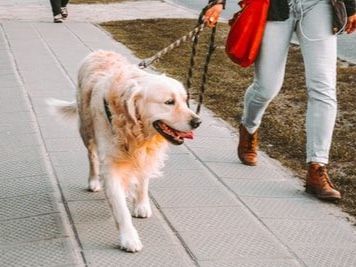It's so amazing the things that they can learn with the right training. You may see dogs on the Internet with amazing skills, however, after trying to teach your dog these same skills, you may have struggled and concluded your dog is not smart enough. Is this really the case? Well, there are 3 easy methods for effective training and this blog is going to consider how you can use them with your dog.
Luring
Luring is exactly as it sounds. To teach your dog to move into different positions, such as sit, down or stand, you use a treat in your hand to lure your dog into the correct position. So, for a sit, you hold the treat at the height of your dog's nose and slowly move it upwards towards your dog's eyes. Your dog will naturally look up to follow your hand and will then move into a sit, in order to reach the treat. For a down position, you take your treat down to the floor and hold it still, to encourage your dog to lower their chin to the ground, until they eventually drop into the down position.
The key to effective luring, is moving your treat hand really slowly, so that your dog's nose is actually touching your hand. If you move it to quickly, your dog won't be able to follow and will become confused. Once your dog has had plenty of practice, you can then speed up the movement of your lure and begin adding a cue word for the behaviour.
Shaping
You can also use what is called shaping to teach a desired behaviour. Shaping doesn't immediately teach the final behaviour, rather it breaks it down into smaller steps, in order to work towards it. For example, in order to teach your dog to roll over, your dog needs to be able to do a reliable down, so you would teach that behaviour first and reward your dog each time.
Once your dog has practiced "down", you would then take your treat to your dog's nose and slowly move it to your dog's shoulder, so using a combination of luring and shaping. When your dog is lying on their side, with their head turned towards their shoulder, you would begin rewarding that behaviour instead of the down. After practicing that step, you would then start using that treat to move your dog onto their back and so on.
So you break it up into easy steps and then up the criteria, once your dog can do each step reliably. Once your dog can complete all the steps and roll over, you can add your cue word. In order to use shaping effectively, you need to ensure that you don't reward behaviours you don't want, as this will confuse your dog. Be clear about what behaviour you are rewarding for each step and if your dog becomes frustrated, go back to practicing the previous step.
Capturing
Capturing involves waiting for your dog to voluntarily offer the behaviour and then rewarding the behaviour accordingly. For example, some dogs struggle with the down position despite the use of luring, so instead you can quietly wait with some treats, for your dog to lie down. The moment they do, you need to praise them and immediately give them a treat. Then you would go back to waiting for your dog to voluntarily lie down again and then immediately reward the behaviour.
With regular repetition and quick delivery of treats, your dog will begin to notice a connection between the behaviour and the consequence and will begin repeating the behaviour. The key to capturing, is being both patient and observant, so you are ready to reward the behaviour the moment it happens.
Trouble Shooting
What if you have tried all these methods and your dog is still struggling? Firstly, consider the environment you are training in. Is there too many distractions? It can be very difficult to learn a new skill in a noisy environment, so when we are training, we need to ensure that it’s an appropriate environment for learning.
Secondly, consider the rewards you are using. Does your dog like the treats you are using? Do you need to use an extra special treat to teach your dog a new skill? When dogs seem unresponsive to training, guardians often conclude their dog is stupid, ignorant or just stubborn, but this is not the case. Dogs display and repeat behaviours that are rewarding to them. So, if you aren't offering a high enough value reward, your dog may not be willing to work.
You may also need to determine if you are using the right kind of reward. Some dogs may value toys and play more than food. Therefore, take the time to find out your dog's favourite rewards by giving them choice and seeing which works best.
Finally, do you have the right state of mind to be training? If you are tired and impatient, this will be evident in your countenance and tone of voice. You want training to be fun for your dog in order for them to be confident enough to try new things. You also need to create a safe learning environment, so that your dog isn't in trouble if they try something and they get it wrong. Mistakes are inevitable when teaching your dog something new and, in all honesty, when they don't understand what we are asking, it is us that is usually at fault.
Your dog's potential is only limited by your lack of belief in them. As Susan Garrett says, "Your dog is a reflection of your ability as a trainer". So work as a team, believe in your dog and have fun learning together!
Start Your FREE Skill-Hub Trial Today
Commitment Free 3 Day Access
Canine Principles' Skill-Hub allows unlimited* access to ALL self-study courses, workshops & webinars.
*Requires Monthly Subscription. See Skill-Hub Subscription Page For Details.

